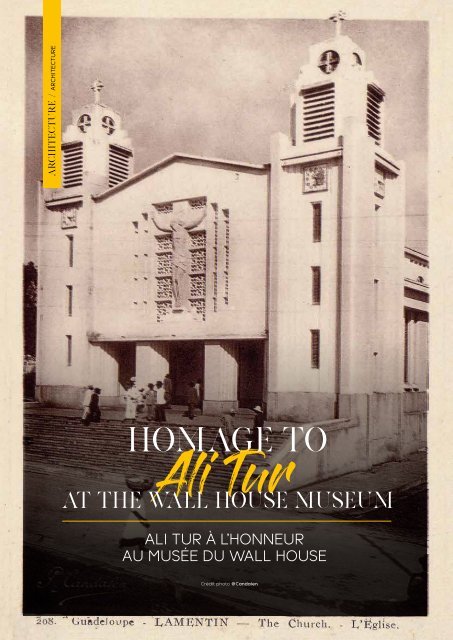TC_04_V16
Create successful ePaper yourself
Turn your PDF publications into a flip-book with our unique Google optimized e-Paper software.
ARCHITECTURE / ARCHITECTURE<br />
ARCHITECTURE / ARCHITECTURE<br />
Saint Barthélemy pays tribute to architect Ali<br />
Tur with a retrospective of his work on the<br />
reconstruction of Guadeloupe in the 1930’s. An<br />
interview with Charles Moreau, curator at the Wall<br />
House Museum in Saint Barthélemy.<br />
Interview by / Propos recueillis par Olivier Aussedat<br />
Saint-Barthélemy salue l’architecte Ali Tur à travers<br />
une rétrospective sur son travail de reconstruction<br />
de la Guadeloupe dès 1930. Entretien avec Charles<br />
Moreau, conservateur du Musée du Wall House à<br />
Saint-Barthélemy.<br />
HOMAGE TO<br />
Ali Tur<br />
AT THE WALL HOUSE MUSEUM<br />
ALI TUR À L’HONNEUR<br />
AU MUSÉE DU WALL HOUSE<br />
Crédit photo @Candalen<br />
The Commuter - What motivated the Wall House to<br />
celebrate the work of Ali Tur in Guadeloupe?<br />
Charles Moreau - To fulfill its role as a pedagogical<br />
institution, the mission of the museum is to present the<br />
widest possible range of subjects in the arts. In Saint<br />
Barthélemy, where construction is a political hot potato,<br />
it is interesting to investigate the history of architecture.<br />
In doing so, this exhibit takes us back to a particular<br />
period for a major art form, that of Art Deco in the<br />
1930’s. This artistic movement did not influence Saint<br />
Barthélemy, yet the most remarkable regional example<br />
is the work of Ali Tur in Guadeloupe, completed before<br />
1937. A rare occurrence for the French West Indies to<br />
have experienced such a totally revolutionary style and<br />
technique on such a large scale.<br />
<strong>TC</strong> - After the destruction caused by a major hurricane<br />
in 1928, Ali Tur, one of the ten architects working<br />
with the Colonial Ministry in Paris, was called to<br />
Guadeloupe to reconstruct a handful of governmental<br />
buildings. But by the time he was finished, the<br />
architect had designed more than 100 edifices on the<br />
island…. How did Ali Tur come to reshape much of the<br />
urban landscape in Guadeloupe?<br />
CM - Ali Tur attended the École des Beaux-Arts in<br />
Paris, where he studied in the atelier of one of its most<br />
important professors at that time,<br />
Victor Laloux, who taught him<br />
about new construction techniques.<br />
In December 1928, after the<br />
destruction caused in Guadeloupe<br />
by hurricane Okeechobee, Ali Tur,<br />
who ran an architectural firm in the<br />
French capital, was contracted to<br />
rebuild administrative monuments in<br />
the Guadeloupe archipelago. After<br />
the work began in 1930, a group of<br />
island officials became aware of<br />
the building that was taking place—<br />
at a time when construction was a<br />
symbol of modernity—and decided<br />
to rebuild town halls, schools,<br />
markets… That meant Ali Tur would<br />
also work for various towns, which<br />
led to the reconstruction of almost<br />
all of the institutional architecture in<br />
Guadeloupe between 1930 and 1937.<br />
The Commuter - Qu’est-ce qui aura motivé le Wall House à<br />
célébrer l’œuvre d’Ali Tur dans l’archipel guadeloupéen ?<br />
Charles Moreau - Afin de remplir son rôle de pôle éducatif,<br />
le musée s’est donné pour mission de présenter un panel le<br />
plus large possible du domaine des arts. À Saint-Barthélemy,<br />
où la construction est un enjeu politique, il est intéressant<br />
de se pencher sur l’histoire de l’architecture ; ainsi, cette<br />
exposition a souhaité se replonger dans une période particulière<br />
pour cet art majeur, celle des années ‘30 et du style<br />
Art déco. Un mouvement artistique absent de Saint-Barthélemy,<br />
dont l’exemple le plus remarquable reste le travail d’Ali<br />
Tur en Guadeloupe, avant 1937. Un moment rare pour les<br />
Antilles, qui aura vu alors le déploiement à grande échelle<br />
d’un style et d’une technique totalement révolutionnaire.<br />
<strong>TC</strong> - Suite aux ravages du Cyclone de 1928, Ali Tur, qui<br />
compte alors parmi les dix architectes du Ministère des<br />
Colonies à Paris, est appelé en Guadeloupe pour y reconstruire<br />
une poignée de bâtiments gouvernementaux.<br />
Mais au terme de son contrat, l’architecte signera finalement<br />
une centaine d’édifices sur l’île… Comment Ali Tur<br />
en est-il venu à remodeler une partie du paysage urbain<br />
guadeloupéen ?<br />
CM - Ali Tur est passé par l’École des Beaux-Arts de Paris,<br />
dans l’atelier de l’un des plus grands professeurs de l’institution<br />
à cette époque, Victor Laloux, qui lui aura notamment<br />
enseigné les techniques nouvelles de<br />
construction. En décembre 1928, suite<br />
à la destruction de la Guadeloupe par<br />
l’ouragan Okeechobee, Ali Tur, à la tête<br />
d’une agence d’architecture dans la<br />
capitale française, est contacté pour<br />
rebâtir les monuments administratifs<br />
de l’archipel guadeloupéen. C’est<br />
après le début du chantier, en 1930,<br />
prenant connaissance des projets de<br />
construction en cours sur leur territoire<br />
— à l’époque fort symbole de modernité<br />
— qu’un groupement d’élus de<br />
l’île se forme pour réclamer la remise<br />
sur pied de ses hôtels de ville, écoles<br />
ou marchés… Commandant à Ali Tur<br />
un nouvel effort pour le compte des<br />
communes et l’amenant à reconstruire<br />
presque toute l’architecture institutionnelle<br />
de Guadeloupe entre 1930 et<br />
1937.<br />
Portrait d’Ali Tur. Crédit photo : © Peltzer<br />
81

















